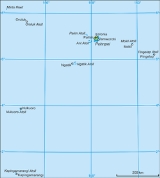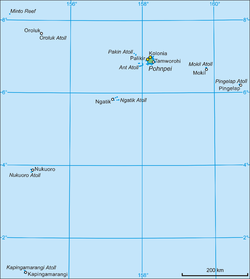
Pingelap
Encyclopedia

Atoll
An atoll is a coral island that encircles a lagoon partially or completely.- Usage :The word atoll comes from the Dhivehi word atholhu OED...
in the Pacific Ocean
Pacific Ocean
The Pacific Ocean is the largest of the Earth's oceanic divisions. It extends from the Arctic in the north to the Southern Ocean in the south, bounded by Asia and Australia in the west, and the Americas in the east.At 165.2 million square kilometres in area, this largest division of the World...
, part of Pohnpei
Pohnpei
Not to be confused with Pompeii, the ancient city destroyed by Vesuvius in AD 79.Pohnpei "upon a stone altar " is the name of one of the four states in the Federated States of Micronesia , situated among the Senyavin Islands which are part of the larger Caroline Islands group...
state of the Federated States of Micronesia
Federated States of Micronesia
The Federated States of Micronesia or FSM is an independent, sovereign island nation, made up of four states from west to east: Yap, Chuuk, Pohnpei and Kosrae. It comprises approximately 607 islands with c...
, consisting of three islands: Pingelap Island, Sukoru and Daekae, linked by a reef
Reef
In nautical terminology, a reef is a rock, sandbar, or other feature lying beneath the surface of the water ....
system and surrounding a central lagoon
Lagoon
A lagoon is a body of shallow sea water or brackish water separated from the sea by some form of barrier. The EU's habitat directive defines lagoons as "expanses of shallow coastal salt water, of varying salinity or water volume, wholly or partially separated from the sea by sand banks or shingle,...
, although only Pingelap Island is inhabited. The entire system has a land area of 1.8 km² (455 acres) at high-tide, and is less than 2.5 miles (4 km) at its widest point. The atoll has its own language, Pingelapese
Pingelapese language
Pingelapese is a Micronesian language spoken on the Pingelap atoll.It is a language featuring both reduplication and triplication....
, spoken by most of the atoll's 250 residents.
History

Japan
Japan is an island nation in East Asia. Located in the Pacific Ocean, it lies to the east of the Sea of Japan, China, North Korea, South Korea and Russia, stretching from the Sea of Okhotsk in the north to the East China Sea and Taiwan in the south...
in October 1914, following the start of World War I
World War I
World War I , which was predominantly called the World War or the Great War from its occurrence until 1939, and the First World War or World War I thereafter, was a major war centred in Europe that began on 28 July 1914 and lasted until 11 November 1918...
, and the southern part of Pingelap Island was occupied by Japan during hostilities in the Pacific Ocean theater of World War II
Pacific Ocean theater of World War II
The Pacific Ocean theatre was one of four major naval theatres of war of World War II, which pitted the forces of Japan against those of the United States, the British Commonwealth, the Netherlands and France....
for a supply base, and was attacked by Allied Forces
Allies of World War II
The Allies of World War II were the countries that opposed the Axis powers during the Second World War . Former Axis states contributing to the Allied victory are not considered Allied states...
. The presence of foreign troops on the island led to the introduction of a number of infectious diseases, including gonorrhoea, tuberculosis
Tuberculosis
Tuberculosis, MTB, or TB is a common, and in many cases lethal, infectious disease caused by various strains of mycobacteria, usually Mycobacterium tuberculosis. Tuberculosis usually attacks the lungs but can also affect other parts of the body...
and dysentery
Dysentery
Dysentery is an inflammatory disorder of the intestine, especially of the colon, that results in severe diarrhea containing mucus and/or blood in the faeces with fever and abdominal pain. If left untreated, dysentery can be fatal.There are differences between dysentery and normal bloody diarrhoea...
, which reduced the population from its pre-war level of around 1000 to 800 and decreased the fertility rate significantly.
Historically, the atoll was ruled by a paramount chief
Paramount chief
A paramount chief is the highest-level traditional chief or political leader in a regional or local polity or country typically administered politically with a chief-based system. This definition is used occasionally in anthropological and archaeological theory to refer to the rulers of multiple...
known as the nahnmariki; a hereditary title which granted certain land rights to its holder. This system remained in place during Japanese rule, although the title was renamed "Island Magistrate". However, with the arrival of the U.S. Navy in 1945, a democratically-elected system was set up alongside the traditional system, which gradually weakened in power. Universal primary education
Primary education
A primary school is an institution in which children receive the first stage of compulsory education known as primary or elementary education. Primary school is the preferred term in the United Kingdom and many Commonwealth Nations, and in most publications of the United Nations Educational,...
was provided for Pingelapese children and a limited health care
Health care
Health care is the diagnosis, treatment, and prevention of disease, illness, injury, and other physical and mental impairments in humans. Health care is delivered by practitioners in medicine, chiropractic, dentistry, nursing, pharmacy, allied health, and other care providers...
scheme was set up to eradicate the diseases introduced during the war.
During the 1960s, the Peace Corps
Peace Corps
The Peace Corps is an American volunteer program run by the United States Government, as well as a government agency of the same name. The mission of the Peace Corps includes three goals: providing technical assistance, helping people outside the United States to understand US culture, and helping...
and U.S. Air Force settled on the main island, constructing a missile watching station in the northeast of the island and a pier, with work beginning in 1978 on an airstrip, jutting into the lagoon, on the main island. The runway was finished in 1982, and currently between 2 and 3 planes per day fly to and from the atoll, operated by Caroline Islands Air.
Typhoon Longieki and Achromatopsia
In 1775, a catastrophic typhoon, Typhoon Liengkieki, swept through the island, killing 90% of the inhabitants and leaving only approximately 20 people. It is believed that one of the survivors, namely Nahnmwarki Mwanenised (the ruler at that time), was a carrier for complete achromatopsia (known on the island as maskun, meaning literally "not see" in Pingelapese), a recessive genetic disorderGenetic disorder
A genetic disorder is an illness caused by abnormalities in genes or chromosomes, especially a condition that is present from before birth. Most genetic disorders are quite rare and affect one person in every several thousands or millions....
which causes total color-blindness in sufferers. All Achromats on this island nowadays can trace their ancestry to this male survivor. However, the achromatopsia disorder did not appear until the fourth generation after the typhoon, where 2.70% of the Pingelapese were affected. By generation 6, the incidence rose to approximately 4.92%. These statistics can be accounted for by inbreeding
Inbreeding
Inbreeding is the reproduction from the mating of two genetically related parents. Inbreeding results in increased homozygosity, which can increase the chances of offspring being affected by recessive or deleterious traits. This generally leads to a decreased fitness of a population, which is...
and two related concepts, the bottleneck effect
Population bottleneck
A population bottleneck is an evolutionary event in which a significant percentage of a population or species is killed or otherwise prevented from reproducing....
and genetic drift
Genetic drift
Genetic drift or allelic drift is the change in the frequency of a gene variant in a population due to random sampling.The alleles in the offspring are a sample of those in the parents, and chance has a role in determining whether a given individual survives and reproduces...
. In the case of achromatopsia on the Pingelap Island, the achromatopsia mutation fluctuated immensely from generation 3 to generation 4 under an extreme form of genetic drift. This type of genetic drift occurs only when the population is extremely small (20 survivors after typhoon) and is also known as the founder effect
Founder effect
In population genetics, the founder effect is the loss of genetic variation that occurs when a new population is established by a very small number of individuals from a larger population. It was first fully outlined by Ernst Mayr in 1942, using existing theoretical work by those such as Sewall...
. Of course, both concepts occur due to inbreeding
Inbreeding
Inbreeding is the reproduction from the mating of two genetically related parents. Inbreeding results in increased homozygosity, which can increase the chances of offspring being affected by recessive or deleterious traits. This generally leads to a decreased fitness of a population, which is...
. To be able to recover the atoll's population as fast as possible, the survivors must undergo a substantial amount of inbreeding in the early generations. Because relatives share many of the same allele
Allele
An allele is one of two or more forms of a gene or a genetic locus . "Allel" is an abbreviation of allelomorph. Sometimes, different alleles can result in different observable phenotypic traits, such as different pigmentation...
s inherited from their common ancestor, there is a high probability that the offspring of two related parents will inherit an identical allele from each parent. Since achromatopsia is an autosomal recessive disorder, inbreeding between the descendants of Nahnmwarki Mwanenised (the typhoon survivor and Achromatopsia carrier) will result in an increased recessive allele frequency.
Today
As of today, the atoll is still of particular interest to geneticistGeneticist
A geneticist is a biologist who studies genetics, the science of genes, heredity, and variation of organisms. A geneticist can be employed as a researcher or lecturer. Some geneticists perform experiments and analyze data to interpret the inheritance of skills. A geneticist is also a Consultant or...
s because of the high occurrence of Achromatopsia
Achromatopsia
Achromatopsia , is a medical syndrome that exhibits symptoms relating to at least five separate individual disorders. Although the term may refer to acquired disorders such as color agnosia and cerebral achromatopsia, it typically refers to an autosomal recessive congenital color vision disorder,...
; due to the small gene pool
Gene pool
In population genetics, a gene pool is the complete set of unique alleles in a species or population.- Description :A large gene pool indicates extensive genetic diversity, which is associated with robust populations that can survive bouts of intense selection...
and rapid population growth, the disorder is now prevalent in almost 10% of the population, with a further 30% being unaffected carriers
Asymptomatic carrier
An asymptomatic carrier is a person or other organism that has contracted an infectious disease, but who displays no symptoms. Although unaffected by the disease themselves, carriers can transmit it to others...
(by comparison, in the United States
United States
The United States of America is a federal constitutional republic comprising fifty states and a federal district...
, only 1 in 33,000, or 0.003%, are affected), leading neurologist Oliver Sacks
Oliver Sacks
Oliver Wolf Sacks, CBE , is a British neurologist and psychologist residing in New York City. He is a professor of neurology and psychiatry at Columbia University, where he also holds the position of Columbia Artist...
to write his 1997 book The Island of the Colorblind
The Island of the Colorblind
The Island of the Colorblind is a book by neurologist Oliver Sacks about achromatopsia on the Micronesian atoll of Pingelap. The second half of the book is devoted to the mystery of Lytico-Bodig disease in Guam.-External links:*...
.

